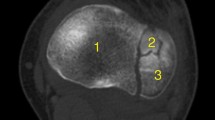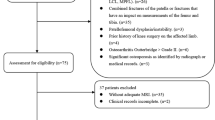Abstract
Purpose
The purpose of this study is to determine the plain radiographic signs that can be indicative of meniscal injuries in Schatzker type II tibial plateau fractures.
Methods
The lateral plateau depression and lateral plateau widening were measured on anteroposterior knee radiographs in 20 patients with Schatzker type II tibial plateau fracture. Meniscal injury was present in 12 patients (three, meniscal tears; nine, peripheral meniscal detachments). The lateral plateau depression and lateral plateau widening measurements were compared between those who had meniscal injury (Group 1) and those who did not (Group 2).
Results
In Group 1, the median lateral plateau depression was 20 mm (IQR: 14–25) and the median lateral plateau widening was 12 mm (IQR: 10–14). In Group 2, the respective values were 10 mm (IQR: 5–17) and 6 mm (IQR: 2–10). There was a statistically significant difference in both parameters when the two groups were compared (p = 0.001).
Conclusions
A plain anteroposterior radiograph depicting a lateral plateau depression ≥14 mm and/or a lateral plateau widening ≥10 mm is associated with a significantly increased risk of meniscal injury in Schatzker type II tibial plateau fractures. These parameters can be used to predict the probable presence of lateral meniscal injury in such patients in routine clinical practice.
Level of evidence
Retrospective comparative study, Level III.


Similar content being viewed by others
References
Abdel-Hamid MZ, Chang CH, Chan YS, Lo YP, Huang JW, Hsu KY, Wang CJ (2006) Arthroscopic evaluation of soft tissue injuries in tibial plateau fractures: retrospective analysis of 98 cases. Arthroscopy 22:669–675
Abdon P, Turner MS, Pettersson H, Lindstrand A, Stenström A, Swanson AJ (1990) A long-term follow-up study of total menisectomy in children. Clin Orthop Relat Res 257:166–170
Barrow BA, Fajman WA, Parker LM, Albert MJ, Drvaric DM, Hudson TM (1994) Tibial plateau fractures: evaluation with MR imaging. Radiographics 14:553–559
Bennett WF, Browner B (1994) Tibial plateau fractures: a study of associated soft tissue injuries. J Orthop Trauma 8:183–188
Boden SD, Davis DO, Dina TS, Stoller DW, Brown SD, Vailas JC, Labropoulos PA (1992) A prospective and blinded investigation of magnetic resonance imaging of the knee. Abnormal findings in asymptomatic subjects. Clin Orthop Relat Res 282:177–185
Colletti P, Greenberg H, Terk MR (1996) MR findings in patients with acute tibial plateau fractures. Comput Med Imaging Graph 20:389–394
Fukuda Y, Takai S, Yoshino N, Murase K, Tsutsumi S, Ikeuchi K, Hirasawa Y (2000) Impact load transmission of the knee joint-influence of leg alignment and the role of meniscus and articular cartilage. Clin Biomech (Bristol, Avon) 15:516–521
Gardner MJ, Yacoubian S, Geller D, Suk M, Mintz D, Potter H, Helfet DL, Lorich DG (2005) The incidence of soft tissue injury in operative tibial plateau fractures: a magnetic resonance imaging analysis of 103 patients. J Orthop Trauma 19:79–84
Gardner MJ, Yacoubian S, Geller D, Pode M, Mintz D, Helfet DL, Lorich DG (2006) Prediction of soft-tissue injuries in Schatzker II tibial plateau fractures based on measurements of plain radiographs. J Trauma 60:319–323
Hackl W, Riedl J, Reichkendler M, Benedetto KP, Freund M, Bale R (2001) Preoperative computerized tomography diagnosis of fractures of the tibial plateau. Unfallchirurg 104:519–523
Kennedy JC, Bailey WH (1968) Experimental tibial-plateau fractures. Studies of the mechanism and a classification. J Bone Joint Surg Am 50:1522–1534
Kode L, Lieberman JM, Motta AO, Wilber JH, Vasen A, Yagan R (1994) Evaluation of tibial plateau fractures: efficacy of MR imaging compared with CT. AJR Am J Roentgenol 163:141–147
Markardt BK, Gross JM, Monu JU (2009) Schatzker classification of tibial plateau fractures: use of CT and MR imaging improves assessment. Radiographics 29:585–597
Mustonen AO, Koivikko MP, Lindahl J, Koskinen SK (2008) MRI of acute meniscal injury associated with tibial plateau fractures: prevalence, type, and location. AJR Am J Roentgenol 191:1002–1009
Papagelopoulos PJ, Partsinevelos AA, Themistocleous GS, Mavrogenis AF, Korres DS, Soucacos PN (2006) Complications after tibia plateau fracture surgery. Injury 37:475–484
Rademakers MV, Kerkhoffs GM, Sierevelt IN, Raaymakers EL, Marti RK (2007) Operative treatment of 109 tibial plateau fractures: five- to 27-year follow-up results. J Orthop Trauma 21:5–10
Ringus VM, Lemley FR, Hubbard DF, Wearden S, Jones DL (2010) Lateral tibial plateau fracture depression as a predictor of lateral meniscus pathology. Orthopedics 33:80–84
Schatzker J, McBroom R, Bruce D (1979) The tibial plateau fracture. The Toronto experience 1968–1975. Clin Orthop Relat Res 138:94–104
Schatzker J (2005) Fractures of the tibial plateau. In: Schatzker J, Tile M (eds) Rationale of operative fracture care, 3rd edn. Springer, New York, pp 447–469
Shepherd L, Abdollahi K, Lee J, Vangsness CT Jr (2002) The prevalence of soft tissue injuries in nonoperative tibial plateau fractures as determined by magnetic resonance imaging. J Orthop Trauma 16:628–631
Stevens DG, Beharry R, McKee MD, Waddell JP, Schemitsch EH (2001) The long-term functional outcome of operatively treated tibial plateau fractures. J Orthop Trauma 15:312–320
Walker PS, Erkman MJ (1975) The role of the menisci in force transmission across the knee. Clin Orthop Relat Res 109:184–192
Watson JT, Wiss DA (2001) Fractures of the proximal tibia and fibula. In: Bucholz RW, Heckman JD (eds) Fractures in adults, 5th edn. Lippincott-Williams & Wilkins, Philadelphia, pp 1801–1841
Yacoubian SV, Nevins RT, Sallis JG, Potter HG, Lorich DG (2002) Impact of MRI on treatment plan and fracture classification of tibial plateau fractures. J Orthop Trauma 16:632–637
Author information
Authors and Affiliations
Corresponding author
Rights and permissions
About this article
Cite this article
Durakbasa, M.O., Kose, O., Ermis, M.N. et al. Measurement of lateral plateau depression and lateral plateau widening in a Schatzker type II fracture can predict a lateral meniscal injury. Knee Surg Sports Traumatol Arthrosc 21, 2141–2146 (2013). https://doi.org/10.1007/s00167-012-2195-z
Received:
Accepted:
Published:
Issue Date:
DOI: https://doi.org/10.1007/s00167-012-2195-z




